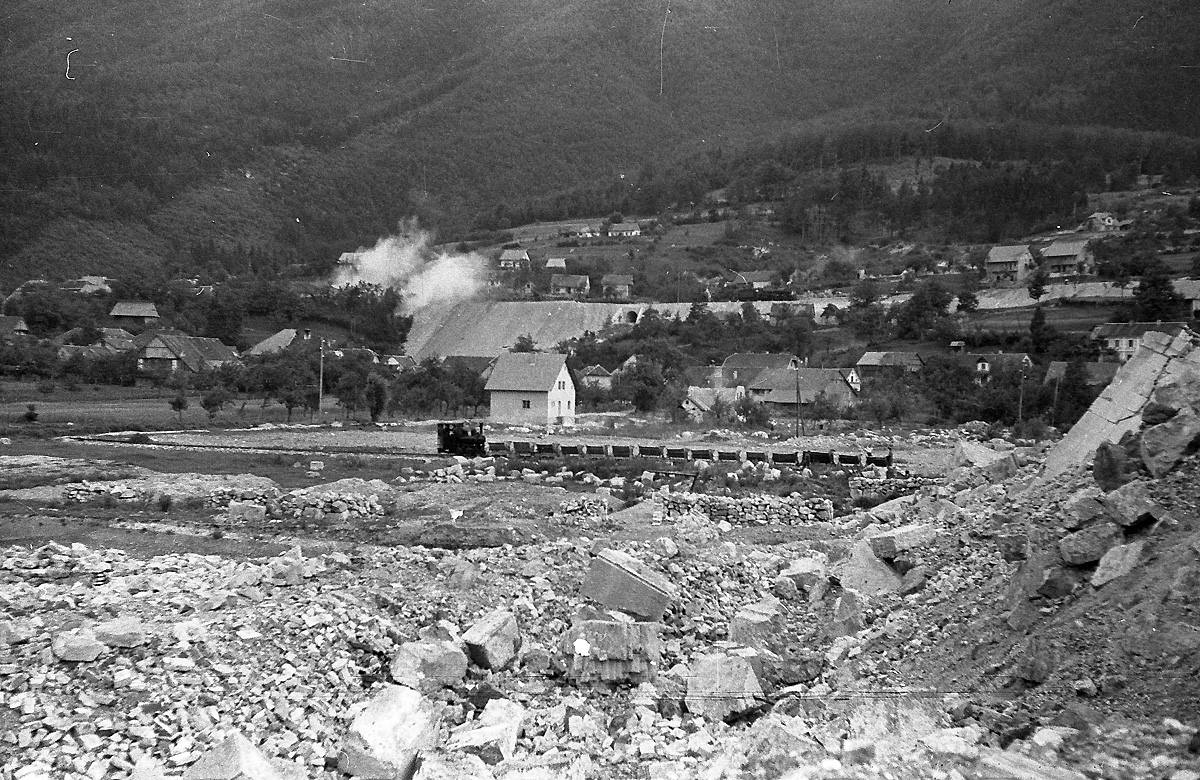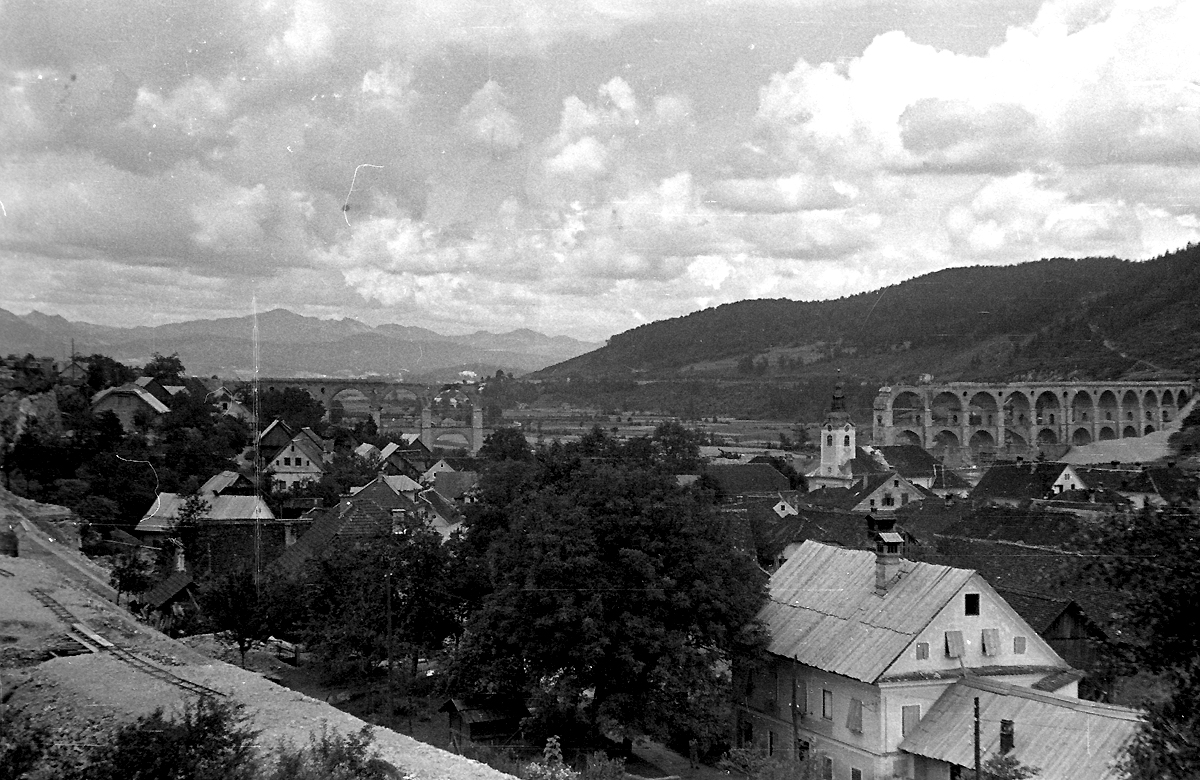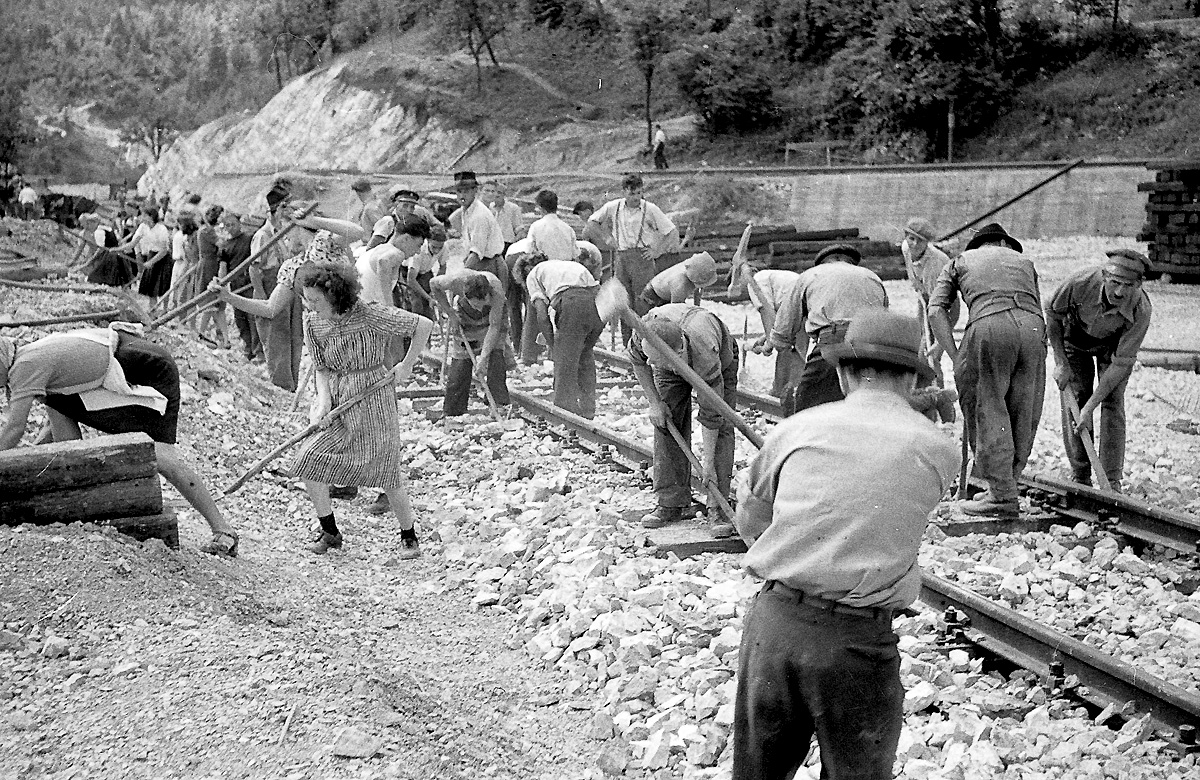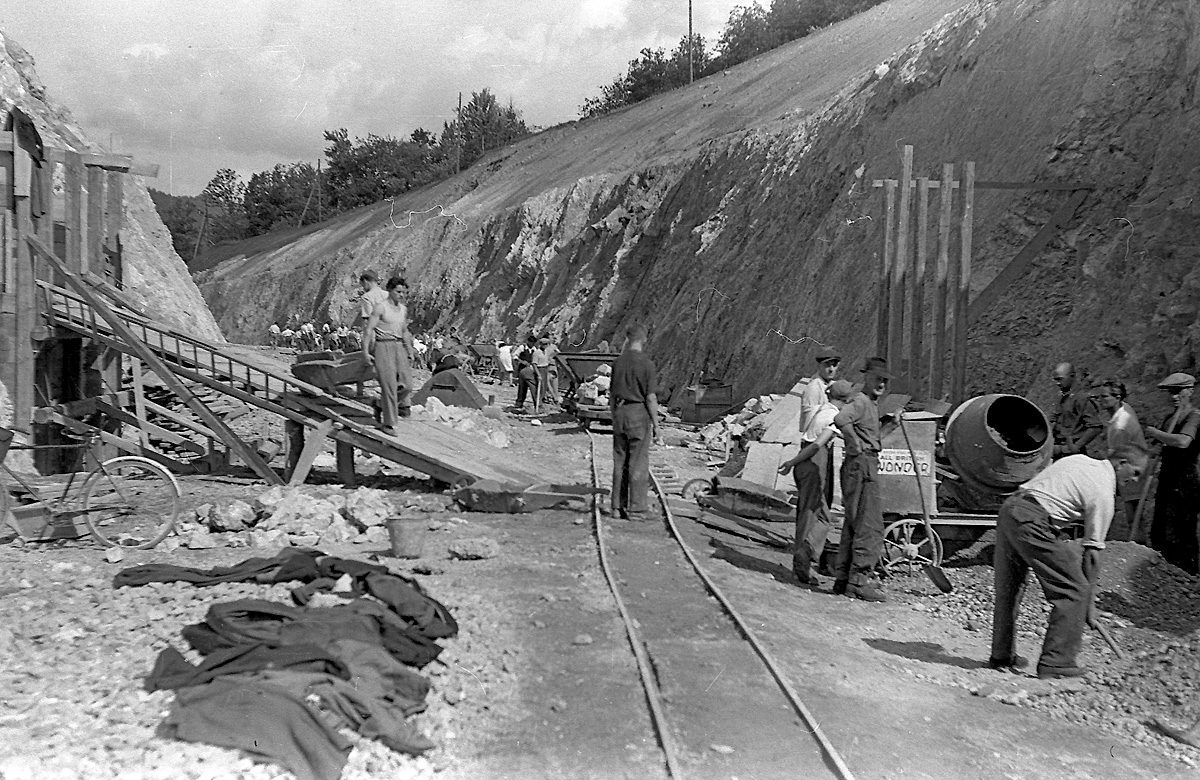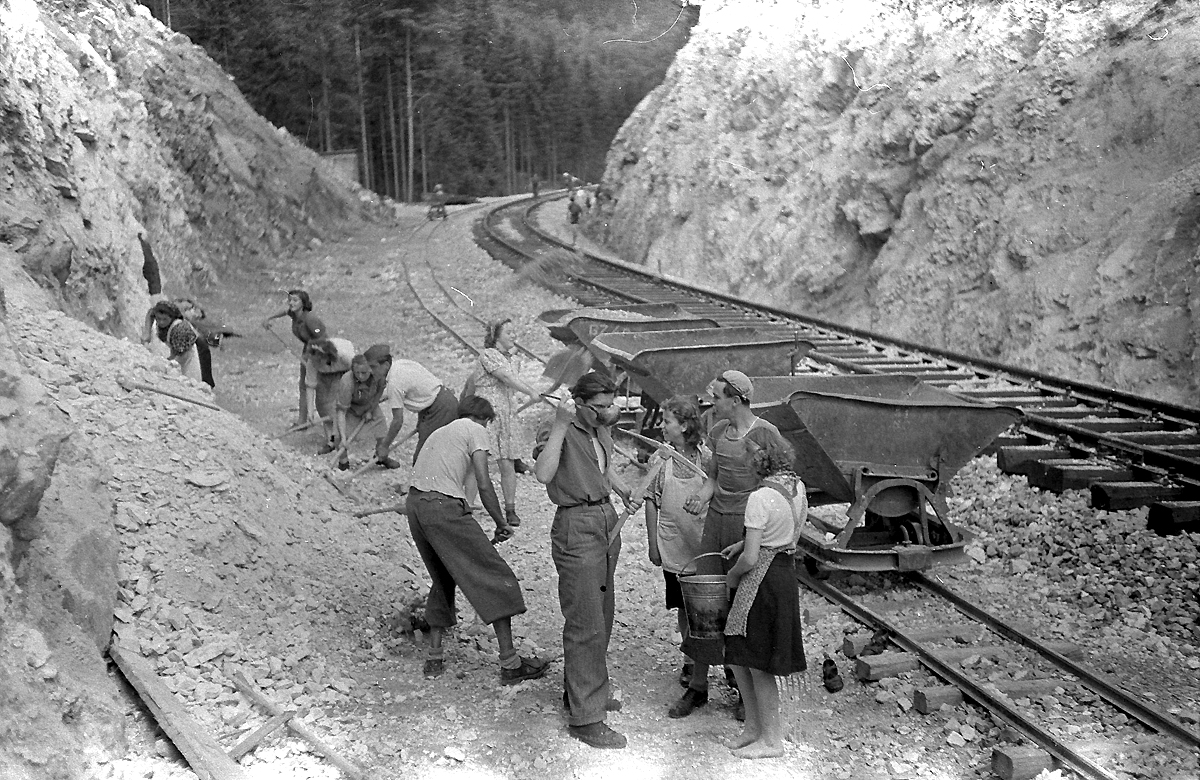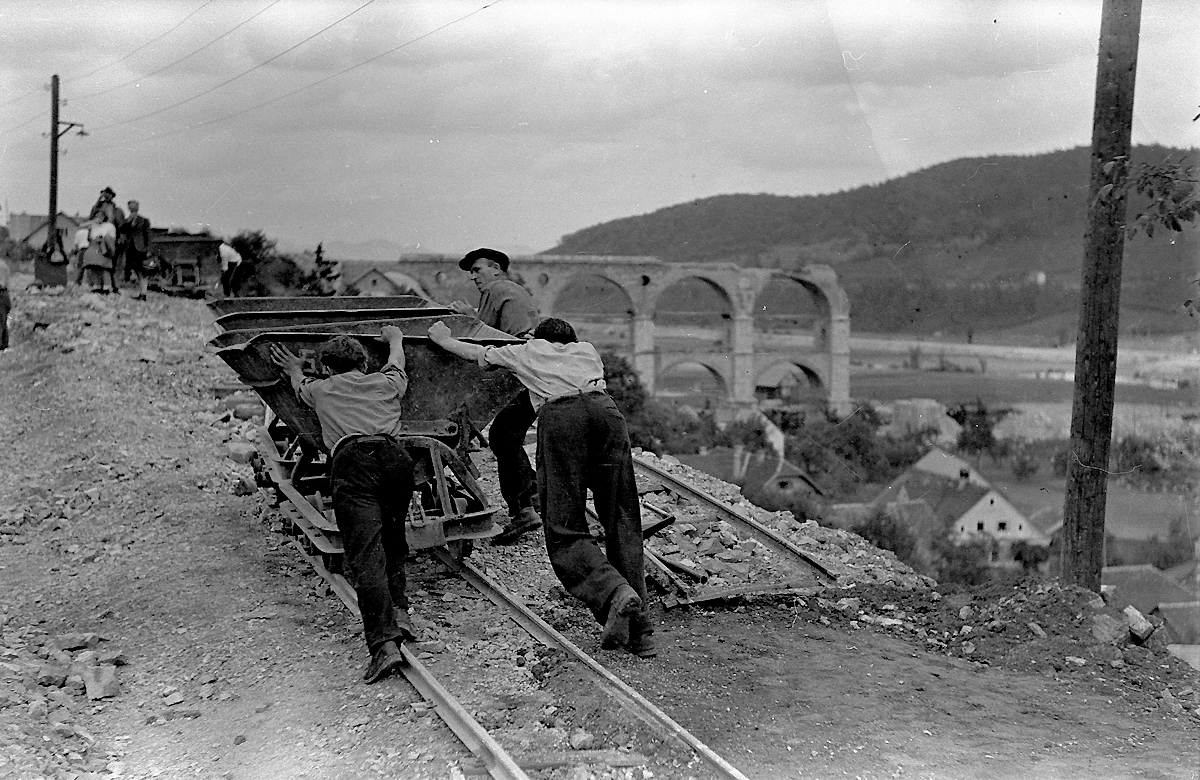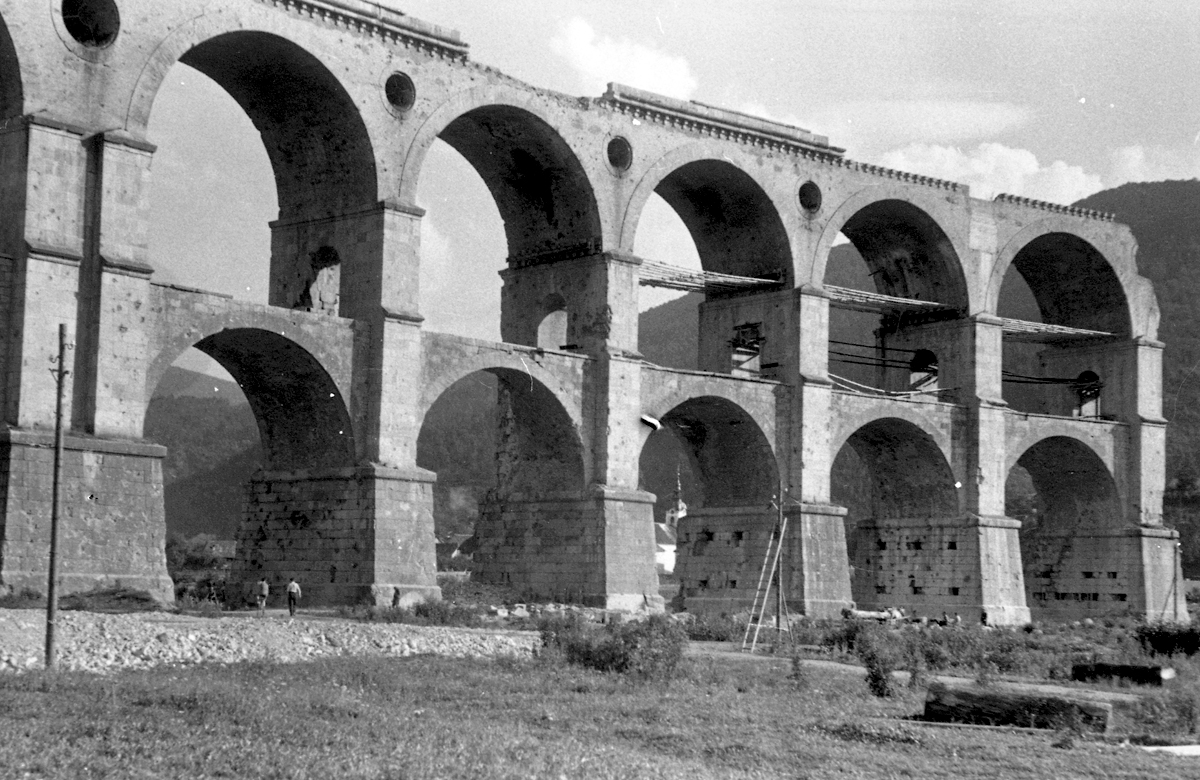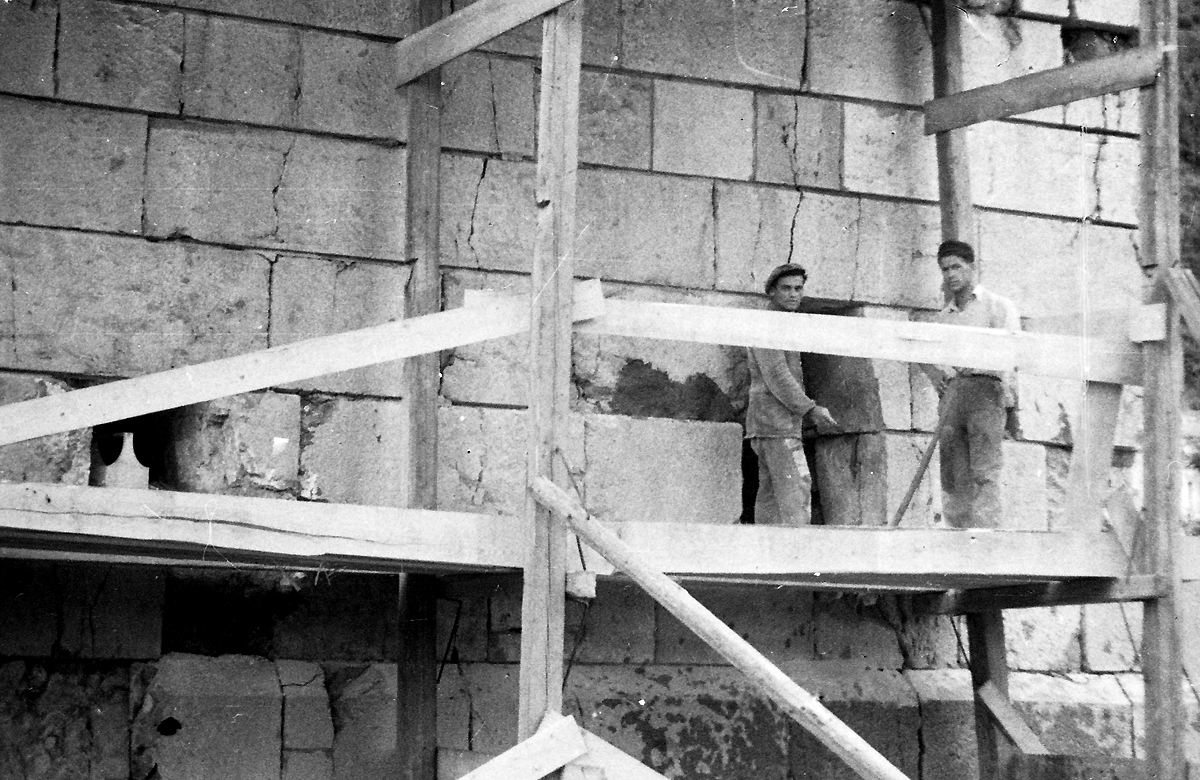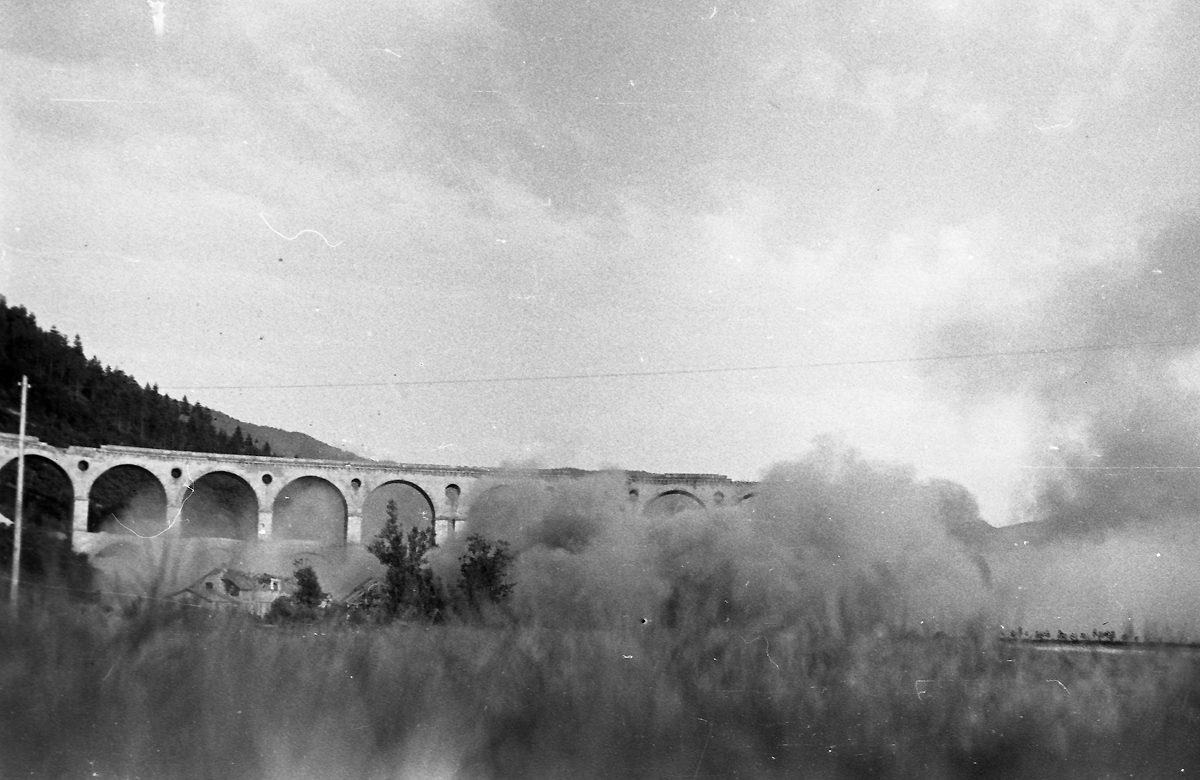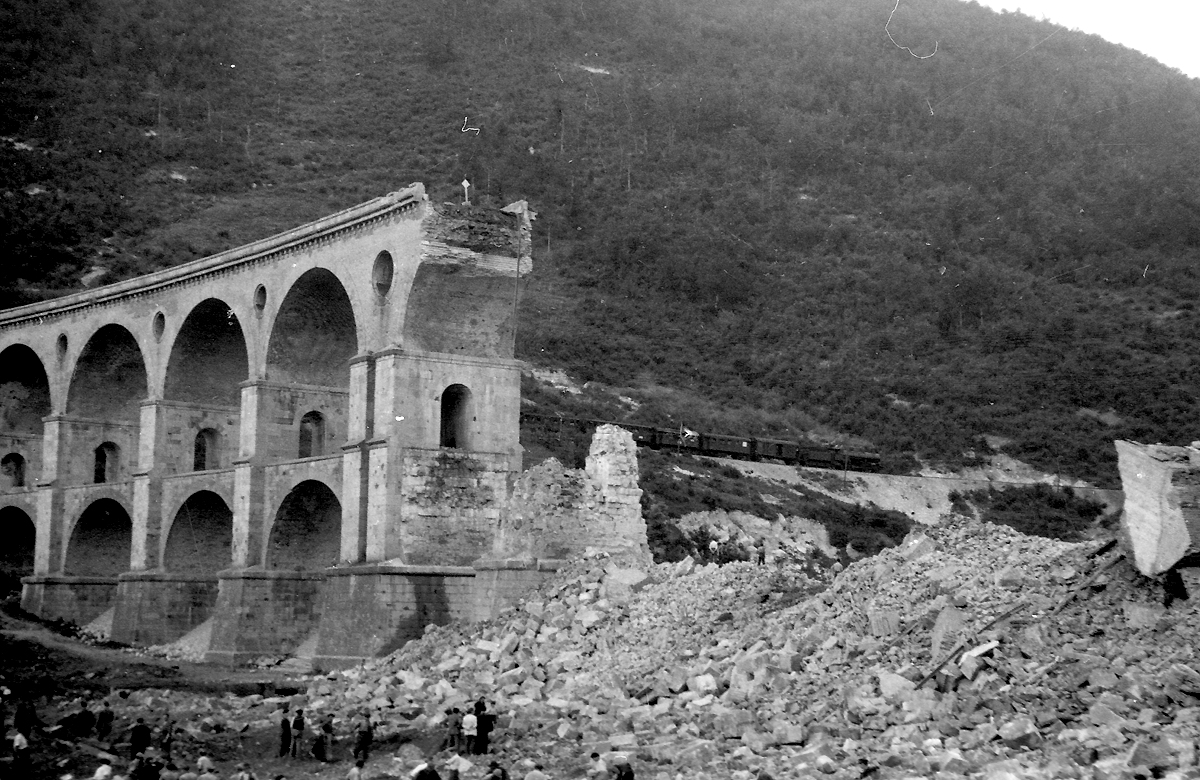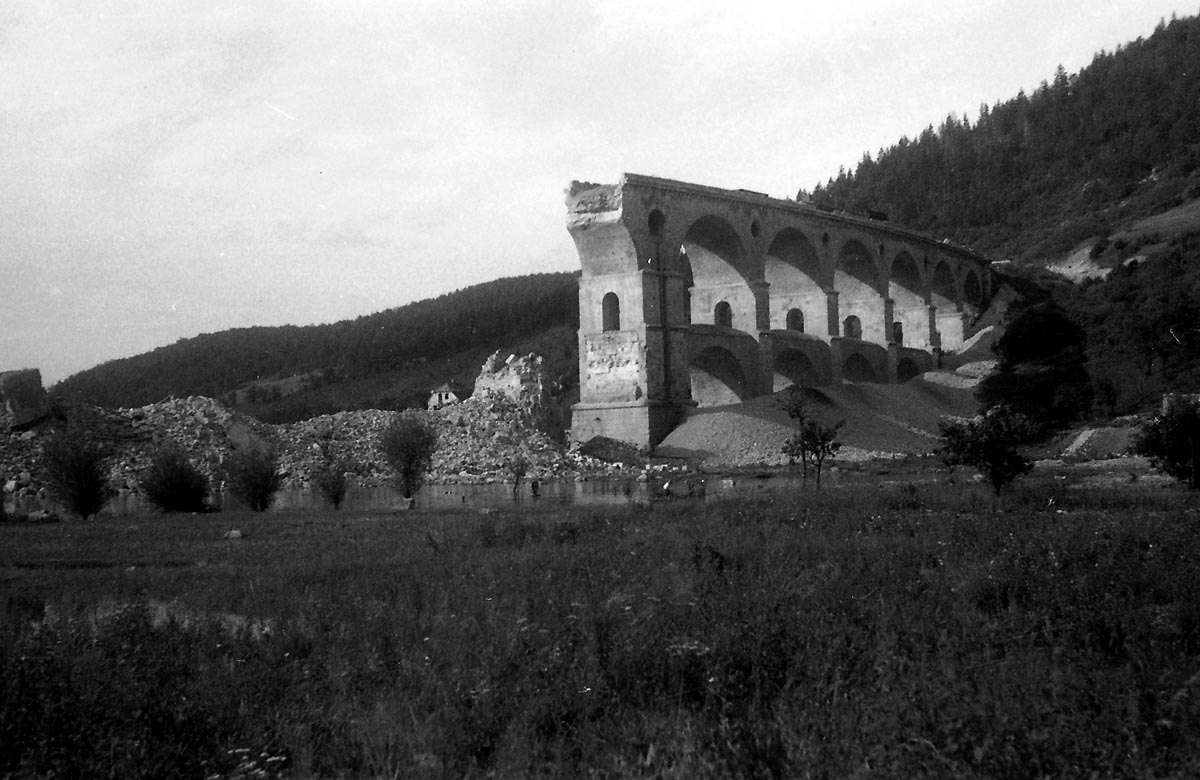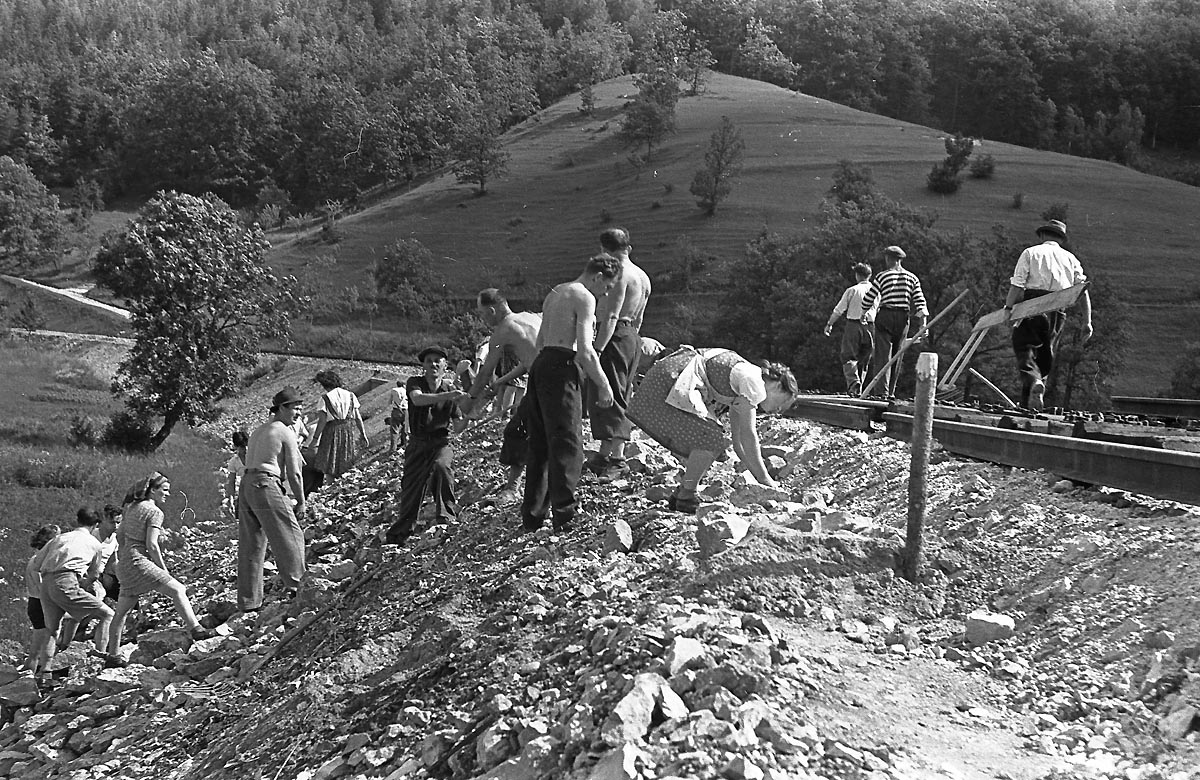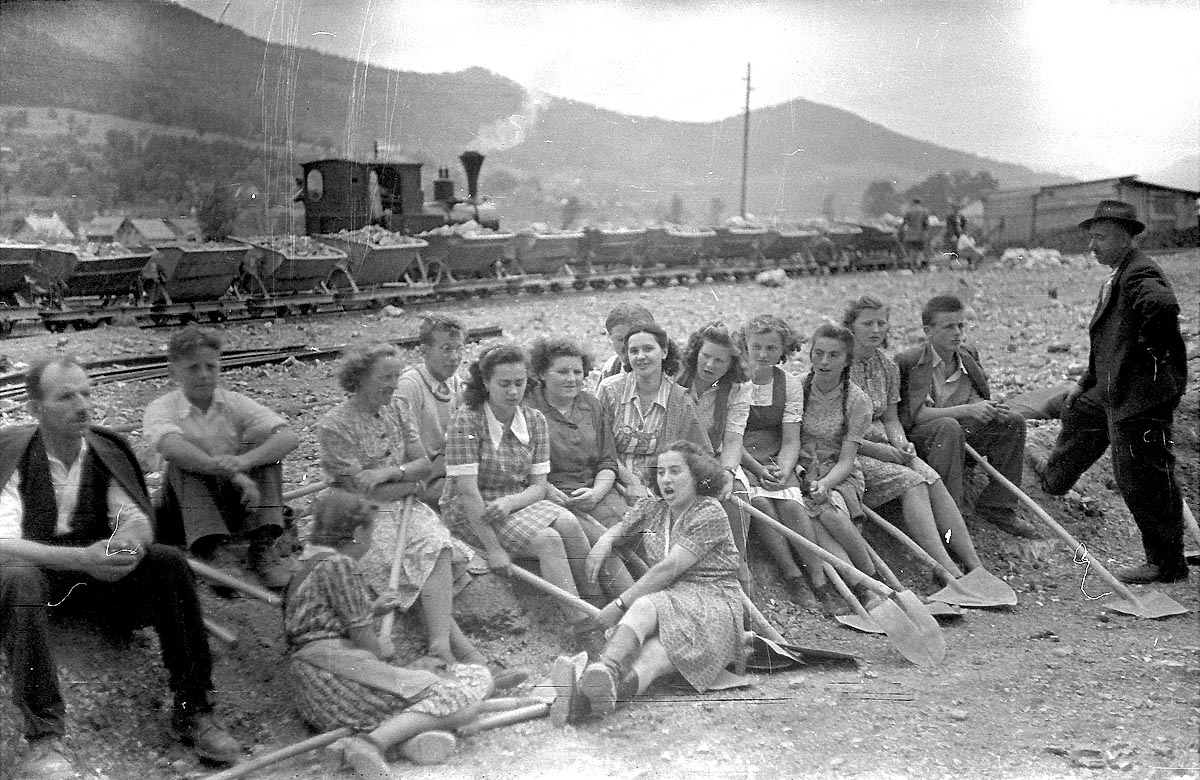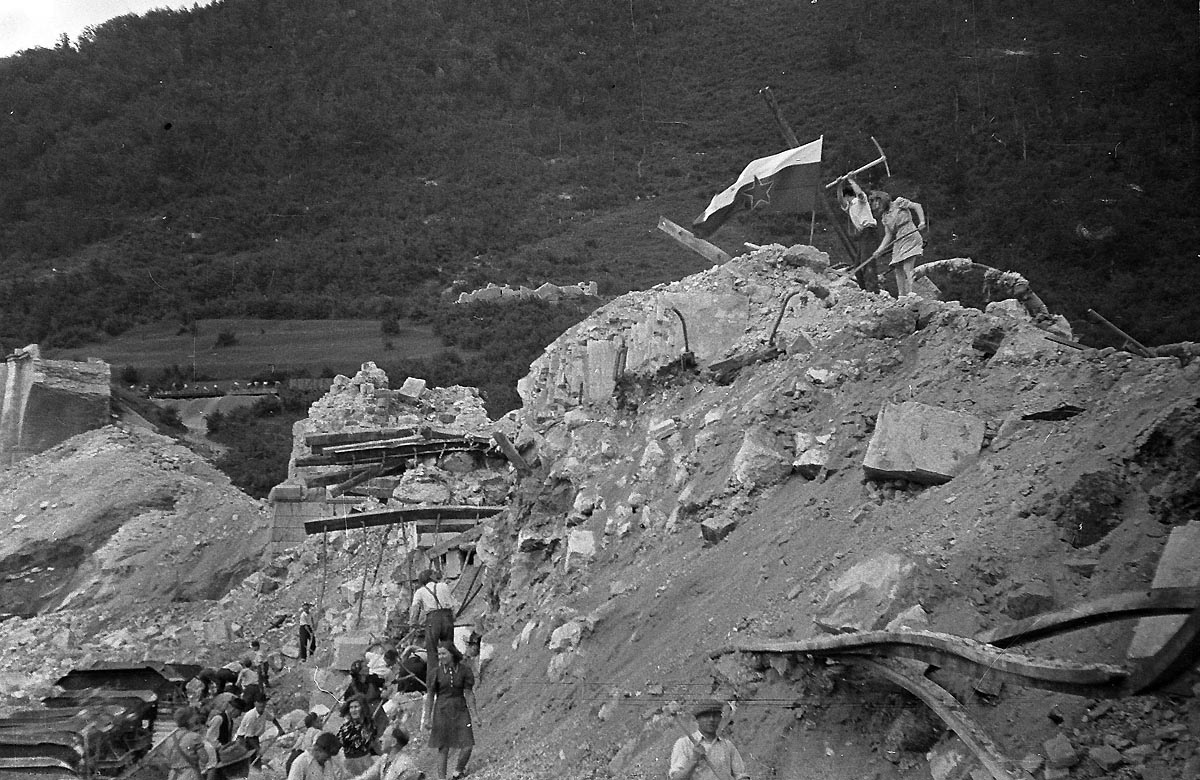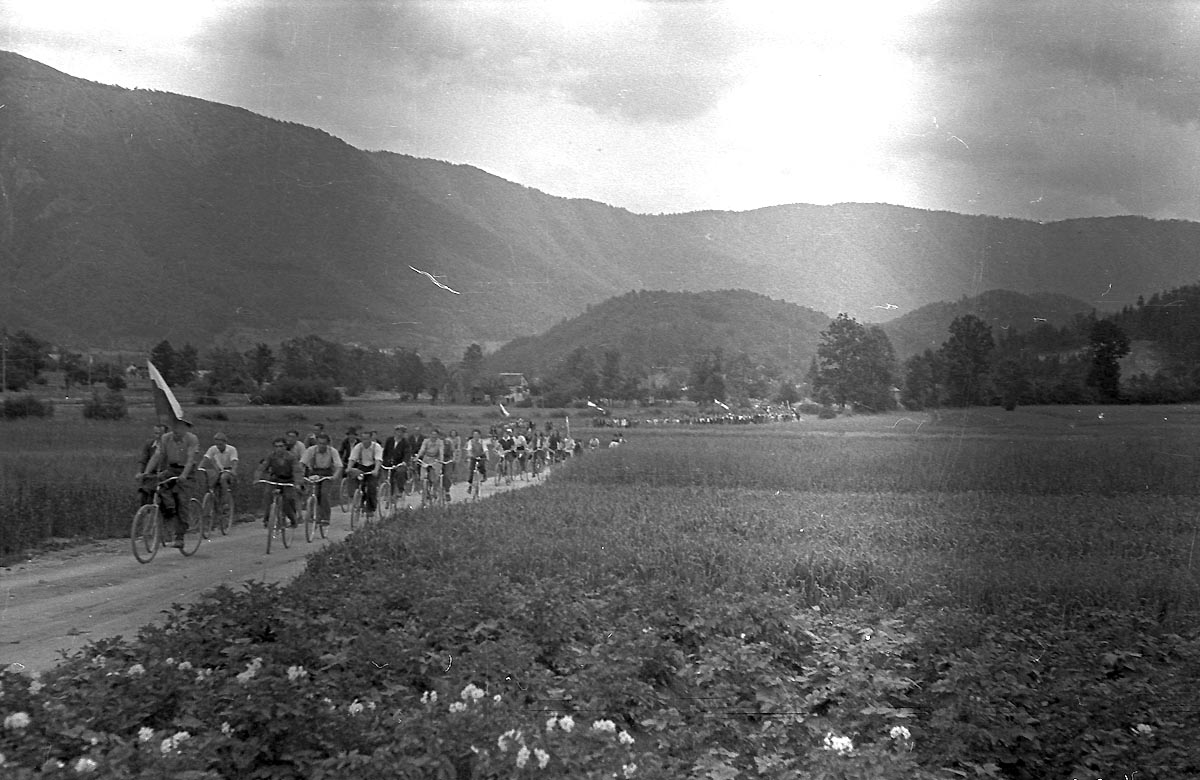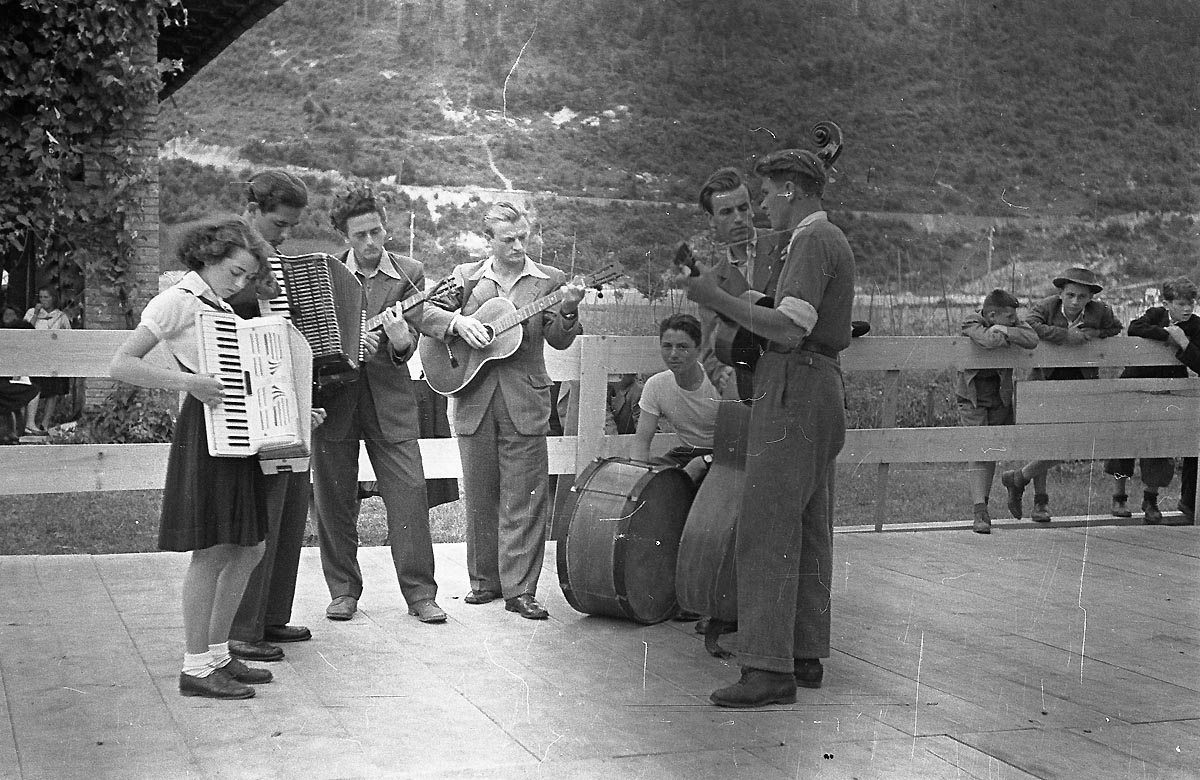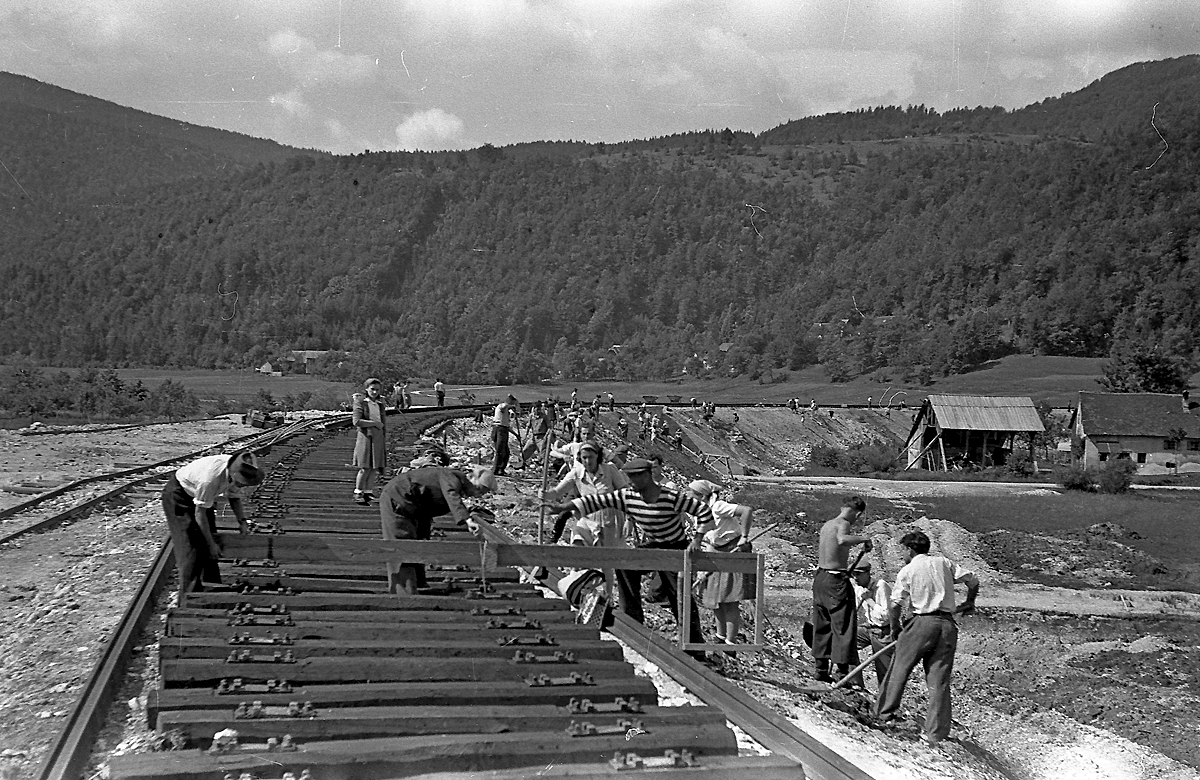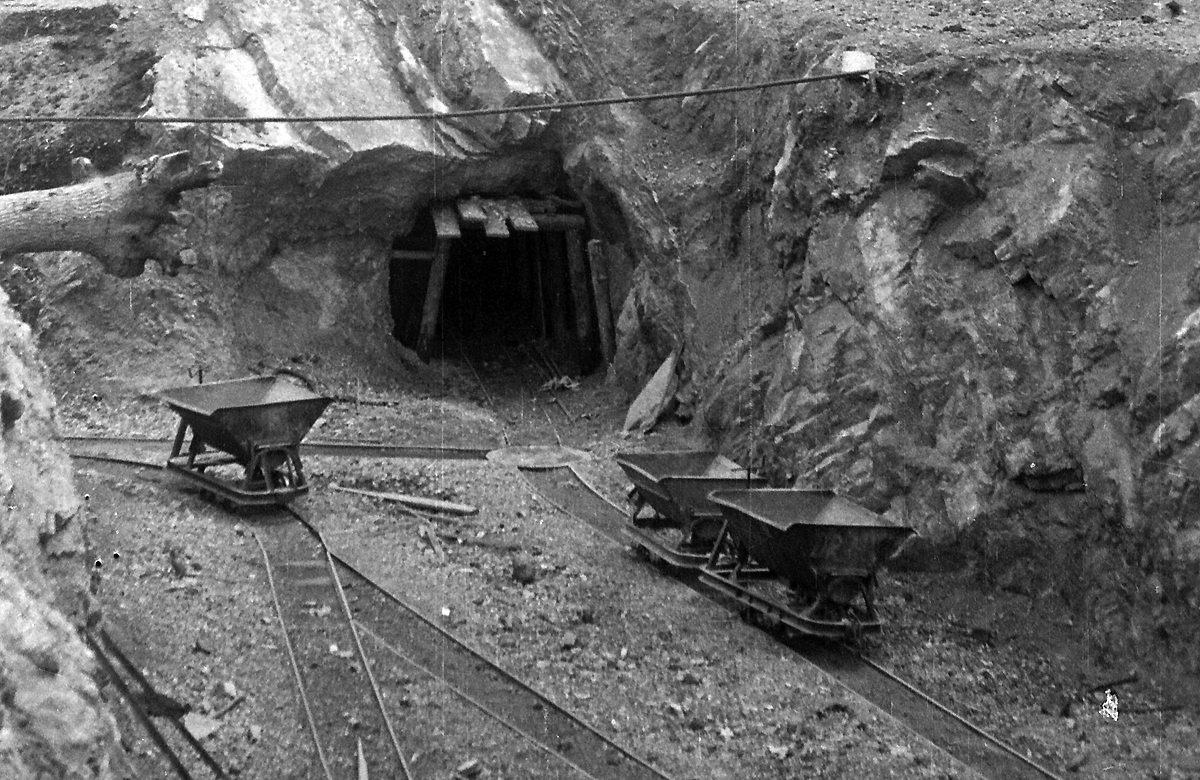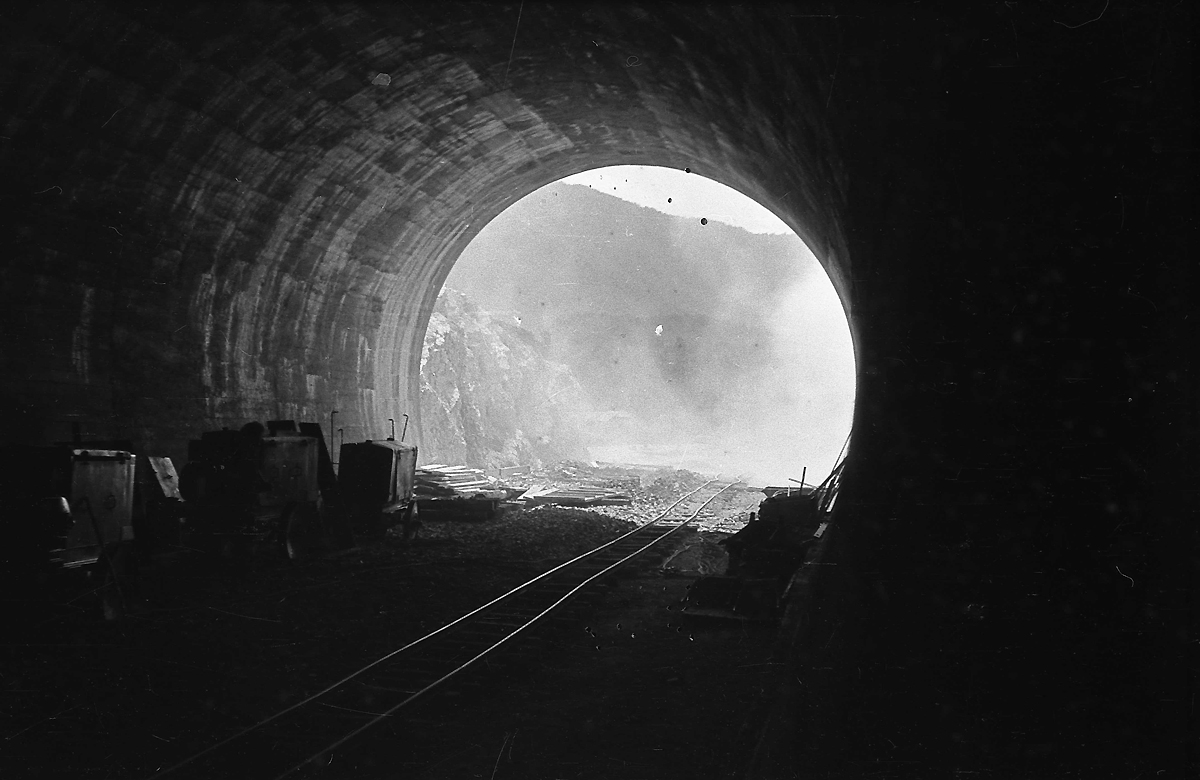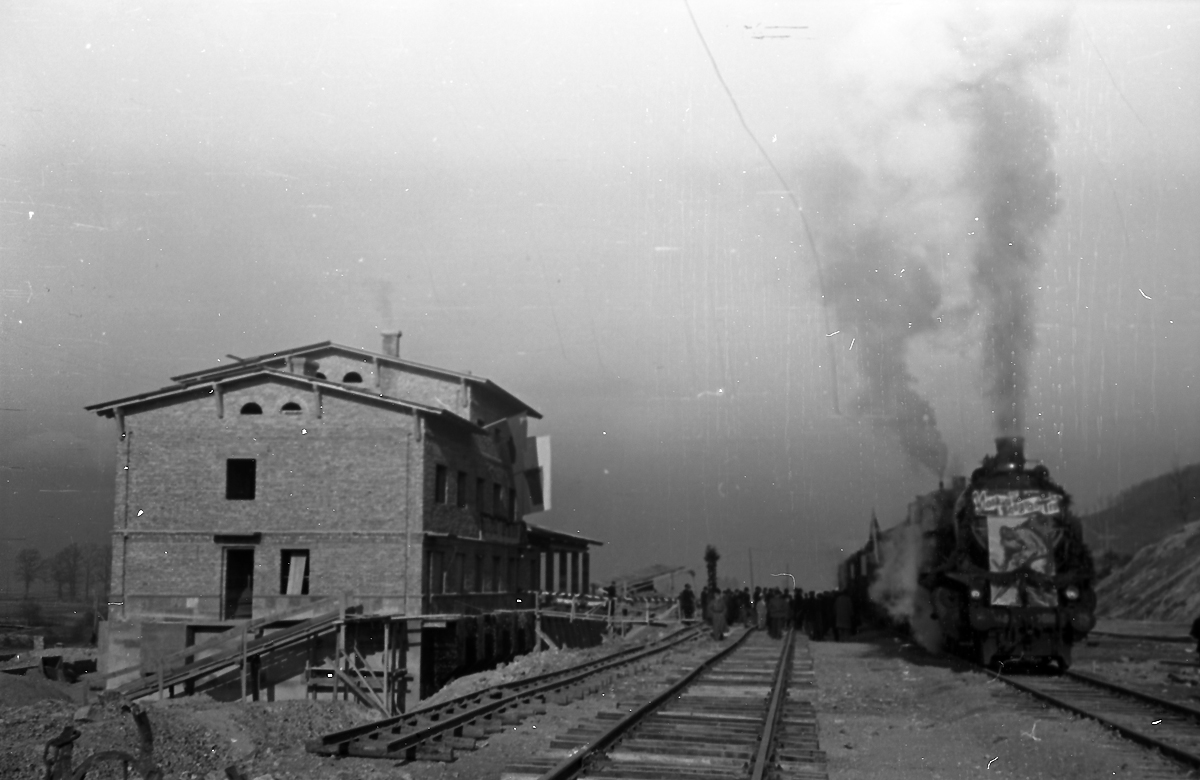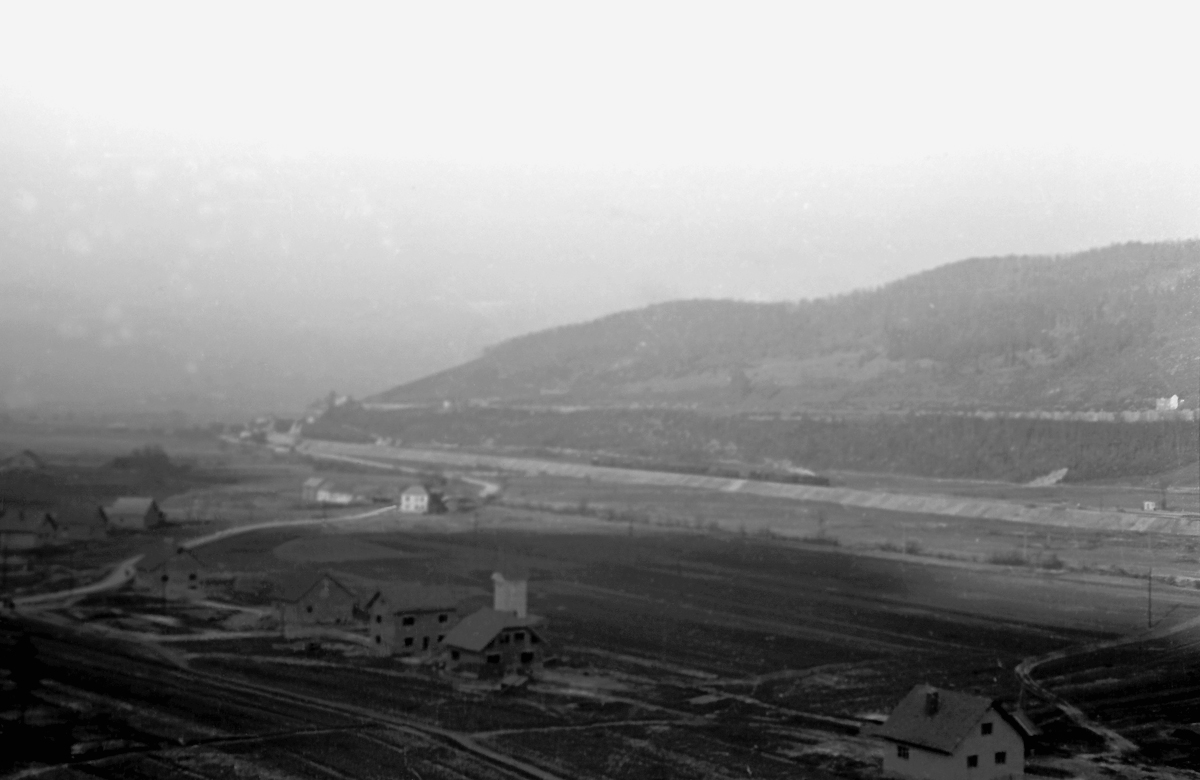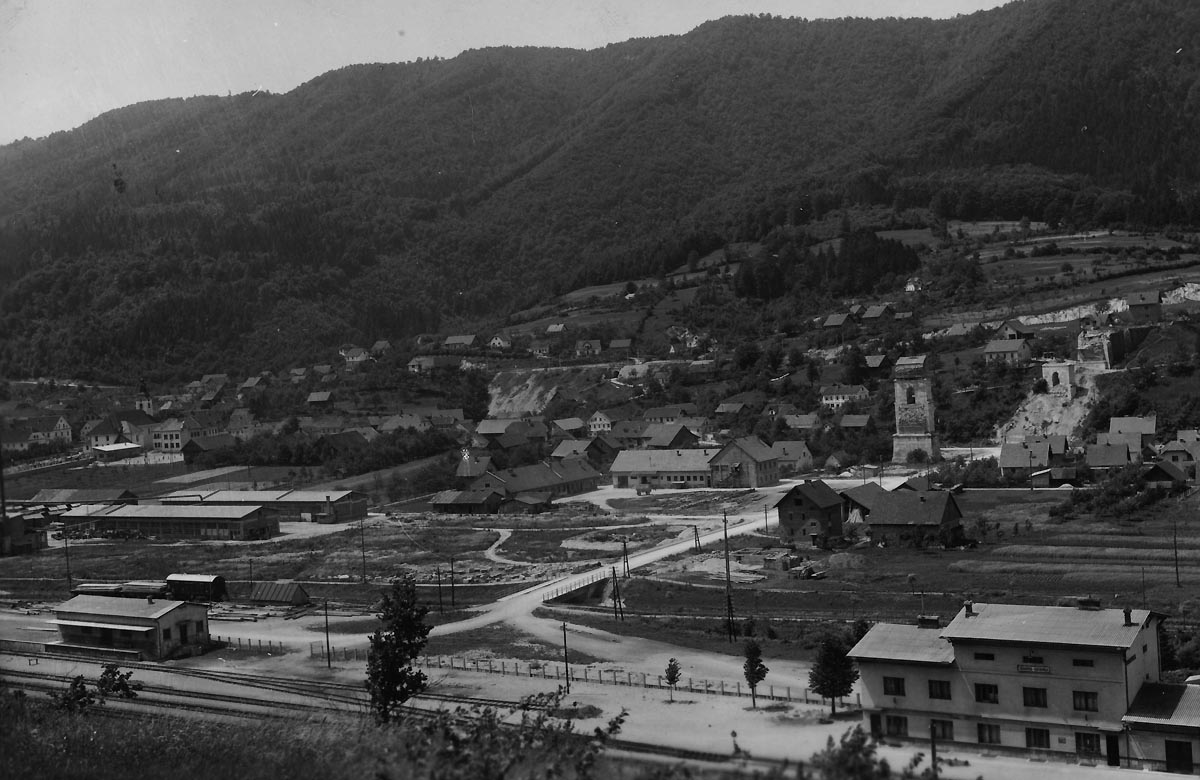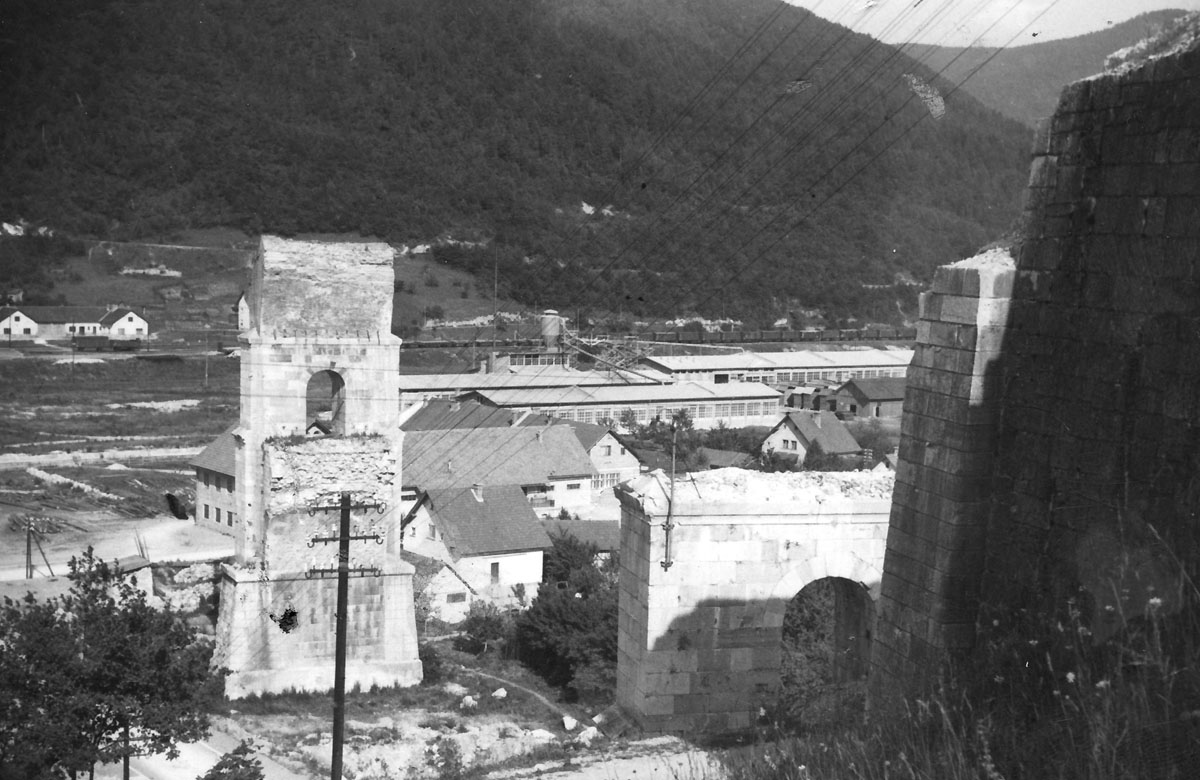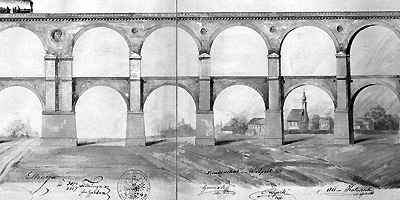
Borovnica railway viaduct 1850 – 1944
Borovnica at the End of World War II
Borovnica was liberated on 6 May 1945, when it was entered by units of the 29th Herzegovina’s Strike Division. German and Home Guard forces had left Borovnica a day earlier. The village welcomed the liberators in ruins. The demolished Roth-Waagner’s viaduct bridging structure lied in a large pile of ruins in the middle of the valley. There was hardly a house in the village not suffering from bombs. Both Majaron’s and Kobi’s sawmills were destroyed. The most beautiful building in Borovnica, the Kobi’s Villa, was also badly damaged. The neighbouring hamlets shared the same fate; they were evicted, burned down and looted during the war. The inhabitants immediately started rebuilding, being assisted by prisoners of war and the army. Therefore, a school, a youth home in the Sokolski dom premises, a parish house, and a church were arranged as a makeshift. According to Slovenski poročevalec newspaper, Obnovitvena zadruga (the Rebuilding Cooperative) somehow managed to supply and distribute 7 wagons of roof- and wall bricks and 3 wagons of cement.
The interrupted railway connection Ljubljana–Trieste required an urgent action. Five new bridges and overpasses were built between Borovnica and Preserje. The Roth-Waagner’s construction of Borovnica was dismantled and transferred to the construction site of the new bridge over the Ljubljanica River. The demolished Pako Viaduct was bridged by a wooden structure. The works were completed in three weeks, and the railway traffic between Trieste and Ljubljana was resumed. The provisional Borovnica passenger station was provided at the railway guardhouse No. 412, just before the Borovnica Viaduct. Traffic along the German bypass route caused significant trouble. Due to the very steep slope, trains ran very slowly and with the help of double heading (two locomotives together). There were numerous derailments; consequently, a normal 2.5-hour journey from Trieste to Ljubljana took as long as up to 12 hours.
After the war, Borovnica was left without electricity. The power plant in Bistra could not provide sufficient power necessary for the renovation and the construction of a new line. Therefore, a power line from Vrhnika to Borovnica was built and completed on 9 August 1945. The work was supported by Kranjske deželne elektrarne (Kranj Regional Power Plant).
The most noticeable event in Borovnica during the period after the Second World War was the construction of a new line, which is detailed below. During its construction, however, public life in Borovnica did not die away. In the former Sokolski dom, a theatre stage was set up, and singing concerts and other gatherings were organised. Ljudska knjižnica (People’s Library) with 1,400 books was opened on 27 January 1946, and become the town’s great acquisition. Borovnica women were organised in AFŽ (Women Anti-fascist Front) and the Red Cross. Immediately after the war, the town had elections to Krajevni ljudski odbori (Local People’s Committees).
Decision on the New Line Route and Blasting the Viaduct Remains
The Borovnica Viaduct had been in a very poor condition even before the Second World War. Therefore, the government of the People’s Republic of Slovenia re-examined the options proposed by the engineer Maks Klodič in 1938. Four proposals were in place, namely: repairing the old Viaduct, building a new one, building a large embankment instead of a viaduct, and building a new bypass. The first three options were practically infeasible due to excessive costs, the shortage of building materials and construction machinery.
Finally, the decision was made on a bypass line, and in mid-May 1945, an order was issued to start the construction of a new line between Preserje and Borovnica based on Klodič’s plans with a few corrections. The new route parts from the old one in Preserje and runs through cuts and over embankments to the new railway station in Borovnica. From Borovnica, the line runs to Dražica where it intersects the German bypass and starts rising, in a large arc, to the Old Station, where it joins the old line to Trieste. Three culverts were made through the embankment, two for the Prušnica and Borovniščica streams, and one for the road leading to the hamlets on the south side of the valley. In addition to embankments and cuttings, it was necessary to bore an 80 m long tunnel. The total length of the new line is 11,083 m, exceeding the original Southern Railway route by 3,209 m. According to Mohorič, the entire construction costs amounted to 240 million dinars, and converted by using the then exchange rate of the National Bank of Yugoslavia, it amounted to USD 4.8 million.
The new railway station was moved to the foot of the Planina hill. Leaving the station, the line ran across the Kobi’s sawmill land to Dražica. This route avoided additional bridges and a regulation of the Borovniščica stream in the length of three kilometres.
Significant obstacles to the new route were the remains of the Borovnica Viaduct located on the eastern side of the valley in the direction to Ljubljana. It was therefore necessary to blow up the remains. Due to the huge amount of material, a decision was made on blowing up the remains in two stages. The first blasting was performed on 17 June 1946 at 7 p.m. Blasting works were managed by the blaster Alojz Babič. The blasters bore six 2.5 m deep holes in each of the first five Viaduct columns and placed three crates of explosives in each hole. Approximately 2,400 kg of explosives were used. Explosions were sequenced in half-a-minute intervals. The ruins dammed the Borovniščica stream, therefore, workers immediately started cleaning the riverbed. Borovnica inhabitants watched the town’s pride turning into ruins for the second time. The remaining six columns were blown up on 17 October 1946. As many as 3,060 kilograms of explosives were placed into the chambers.
In addition to the Borovnica Viaduct remains, the construction of embankments over the Ljubljana Moors caused problems also this time, resembling the trouble faced by the builders in the 19th century. As indicated by Mohorič in his book, from 28 January to 4 February, the embankment between Goričica and Pako sank by 10.6 metres. The 7-metre high embankment between the villages of Pako and Breg slid to the right by 20 metres. This was the reason why even the route had to be shifted.
Laying Out the Route and Organisation of Works at the New Line
The line was supposed to be built as soon as possible. The engineer Klodič estimated the construction to be completed within one year provided that sufficient building materials, labour force, and building machinery were in place. A huge construction site was organised in Borovnica for the removal of the Borovnica Viaduct remains. A small narrow-gauge railway was built for this purpose. The material was used to fill up the bomb funnels and to build the embankment for the new line. Bricks from the demolished Viaduct were used to repair houses and farm buildings. Moreover, in accordance with the ideology and economic policies of that time, even a cooperative centre was built.
Before the construction started, it was necessary to layout the new route and arrange for the land right. According to the plan, the line was foreseen running along the edges of the Moor over arable land and settlements. Therefore, by order of the Ministry of Construction of the People’s Republic of Slovenia, between 17 June and 5 July 1946, a political tour and a local commission inspection were carried out along the entire route. The comprehensive minutes include: identification and assessment of general public benefits related to the construction of the Preserje–Borovnica railway bypass, property (land and buildings) and rights expropriation, hearing of affected property owners (together with expropriated persons’ names, lot numbers, and expropriated persons’ statements and requirements), the survey, and the commission’s conclusions concerning the protection of general public benefits in relation to restoration and regulating works. These minutes also include a note about the preservation of the Borovnica Viaduct remains. Landowners were expropriated, houses on the route were pulled down, and new houses were built for the owners. This is the way the Nova vas settlement began to grow in Borovnica. Construction of the bypass line required approximately 42 hectares of land to be acquired, 23 houses and several farm buildings were pulled down, including the Kobi’s Villa and sawmill, and Majaron’s sawmill.
The construction site in the entire route was divided into 9 sections. The works were taken over by construction companies. It turned out, however, that this decision was not the best one. The organisation of work was poor, workers lived in barely liveable conditions in sheds, with no water and toilets. The food was poor. Building machinery was in shortage. There was also a shortage of skilled workers, especially blasters. Bureaucracy increased excessively, and the works in the construction site progressed slowly. Nevertheless, there was an interesting fact about wages published by Ljudska pravica newspaper on 30 June 1946. Namely, workers’ wages were quite high and classified into the so-called first inflation class. On this account, the companies charged the Railway Administration additional overheads of 68 % and, of course, made a fortune. The circumstances were further worsened by poor trade union organisation of workers. Consequently, in April 1946, the construction of the Preserje–Borovnica line was taken over by the Railway Administration. It cut down on workers’ wages, which caused considerable discontent. Moreover, workers from other construction sites with the works already completed were moved to the line construction site. The issue of salaries was finally regulated by the Ministry of Transport in Belgrade, which classified salaries back to the first inflation class. They also introduced piecework (piecework pay).
The new management introduced a central kitchen and improved the health service. Construction, mechanical, supply, and hygiene services were organised for works at the construction site. The entire supply was commissioned to the Naproza company of Borovnica, which set up three canteens. Shoe repair was taken over by čevljarska zadruga of Vrhnika (Vrhnika Shoemaking Cooperative), while laundry and ironing were also taken over by members of the Women Anti-fascist Front. The trade union was organised anew. All these changes had a positive impact on the course of construction. In June 1946, the volume of excavated material was 27,000 m3, while in July, it amounted to as many as 49,000 m3, with the same number of workers involved. According to additional interesting information, in January 1946, the excavation of one cubic meter of material took 11 hours, compared to only 4.5 hours in September of the same year. Workers were also helped by numerous youth work brigades, located in the nearby Bistra Castle.
(Non-)Completed Works on the New Line
On 18 October 1946, a tunnel of 80 m in length was completed in the section between the Old Railway Station and the German bypass connection. Accordingly, this day was properly celebrated. The tunnel was all lit up and decorated with greenery, flags, and pictures of Marshal Tito and other communist leaders. The following inscription was placed on the portal: “Working people are handing the new tunnel to Tito’s Yugoslavia”. After patriotic speeches, the ribbon was cut by the engineer Milan Bufon. The opening was followed by the social evening in the tunnel.
The works progressed in an accelerated manner, and on 29 June 1947, the first part of the new 3.4 km long line between the Old Station and the German bypass on the other side of the valley, at Dražica, was put to service. The line was opened by the Minister of Labour of the People’s Republic of Slovenia, Tomo Brejc. At this occasion, 15 best workers were declared „udarnik“ (superproductive workers). The ceremony was completed with a cultural event.
The construction of a new railway station was carried out simultaneously with the construction of the new line. The Old Station was squeezed between two viaducts and had no room for expansion. By moving the station to the valley, Borovnica got a modern station building. At the opening of the entire line on 21 December 1947, the station was not fully completed yet.
The main part of the opening of the second 7.9 km long section between Preserje and Borovnica took place in Preserje. The guests then took the train on the new line to Borovnica where they were welcomed by numerous locals. Although the new line was only a single-track line and run by steam locomotives, and not all its facilities were completed, the railway traffic between Ljubljana and Trieste ran quite smoothly.
The line became a double-track line only in the late fifties, and was electrified in the early sixties.
Heating buildings, coal storage facilities, and other service facilities for steam locomotives at the new railway station were never built up.
Last Remains of the Viaduct
After the Borovnica Viaduct remains were blasted for the second time in 1946, only five columns of the once largest railway facility in the Austro-Hungarian Monarchy were left on the western side of the valley in the direction to Postojna. In the above-mentioned minutes from 1946, there is a discussion about what to do with the remains of the mighty Viaduct. It was quite clear that the remains on the east side, in the direction to Ljubljana, had to be removed due to the new line. Representatives of the Railway Administration did not dispute the protection and conservation of the Viaduct remains. Nevertheless, they did not want to cover the related costs and provide for subsequent maintenance. According to Karol Rustja’s notes, at the end of 1946, the Ministry of Transport in Belgrade handed over the Viaduct remains to the Ministry of Education of the People’s Republic of Slovenia.
Restoration plans were developed by two engineers, Marjan Mušič and Ladislav Eleršek, in December 1946. They suggested keeping the columns No. 21, 22, 23 and 24, including the arches between them, and demolishing the rest. The cut-off surfaces should be filled with cement to protect the columns from decay. In 1947, Zavod za zaščito spomenikov (the Monuments Protection Institute) received money for the restoration, but could not find a contractor. Since that time, there has been no money available for the renovation.
In 1948, the Deputy Prime Minister of Slovenia, Ivan Maček, issued an order on demolishing the Viaduct remains and using the material to build cooperative centres. Krajevni ljudski odbor (the Local People’s Committee) of Borovnica complied with this order between 13 and 17 February 1950. As a result from poor blasting, the column No. 21 has survived until today. The half-column No. 24 had also survived, but it had to be pulled down a few years later due to falling stones. Till now, there have been quite a few ideas recorded on how to restore the Viaduct’s remaining column. In April 1953, the engineer Karel Kobler suggested in Slovenski poročevalec letters from readers to place a statue on top of the column, and to level the lower arches and decorate them with frescoes featuring the Liberation War. In January 1992, Skupščina občine Vrhnika (the Municipal Assembly of Vrhnika, which at that time also covered the territory of the present Municipality of Borovnica), declared the last column of the Borovnica Viaduct a technical monument.
At the end of 2021, the Municipality of Borovnica, with the support of the European Regional Development Fund, transformed the park at the column into a theme park, where the Viaduct history, from its planning to its final demolition, is presented in texts and photographs on 9 thematic panels. A memorial path runs from the park to the Old Station building and the west heel of the Viaduct with a belvedere platform, also co-financed by the European Regional Development Fund.
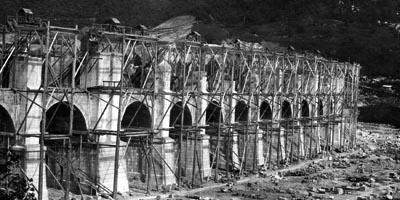
The Viaduct Construction
The Borovnica Viaduct used to be the largest bridging structure in the Southern Railway route between Vienna and Trieste…

Borovnica
At that time, Borovnica, a small village in the southern part of the Ljubljana Moors, had about fifty houses…

The life of Viaduct
The railway line over the Borovnica and other viaducts was insulated with compacted clay…
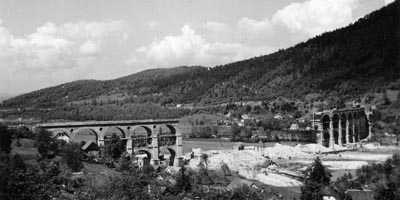
The Second World War
On Easter Thursday, 10 April 1941, at five o’clock p.m., the Borovnica Viaduct was blasted under the command of Captain Žužek…

This website is a part of the project »Thematic Park and Memorial Path of Borovnica Viaduct«, co-financed by the European Fund
for Regional Development (EFRD) throught the Local Action Group Barje z zaledjem.









